Narrative Writing
- harrisonse
- Feb 24, 2021
- 7 min read
Recently I explored two wonderful children's books that could easily be implemented in a lesson centered around teaching students how to write engaging narratives. Students may struggle to create a worthwhile narrative, whether it's because they are trying to finish the task as quickly as possible or because they don't know exactly what it means to be a narrative writer, there are many strategies you could share with your students that would allow them to enhance their personal narratives. Before I begin discussing these strategies with you, first let me share a bit of information about each of the books I referenced earlier.

The first book I will talk about is I Talk Like a River, written by Jordan Scott and illustrated by Sydney Smith. In this book a story about a young boy with a stutter is told in a poetic way. He shares how for him words get trapped and tangled in his throat, coming out all mangled. Words do not effortlessly slide off of his tongue like they do his peers and they laugh as he struggles to form the words, making him feel like an outcast. This remained true until one day, the boy and his father went on a trip to the river. During their visit, the boy's outlook toward himself changed when his father compared his speech to the bubbling, churning, whirling, and crashing water of the river. The boy not only enjoys the peaceful surroundings when visiting the river but he also appreciates what it is the river stands for. To him the river represents the natural beauty of both chaos and peace, which are terms he could relate to, "I talk like a river." In the end, he was thrilled to proudly share a story about his favorite place, the river, with his classmates.
One thing that stood out to me in this story were the powerful illustrations. I especially liked how the author continued to revisit the letters P, C, and M throughout the beginning of the story. Here I am including the sequence of illustrations I am referring to.
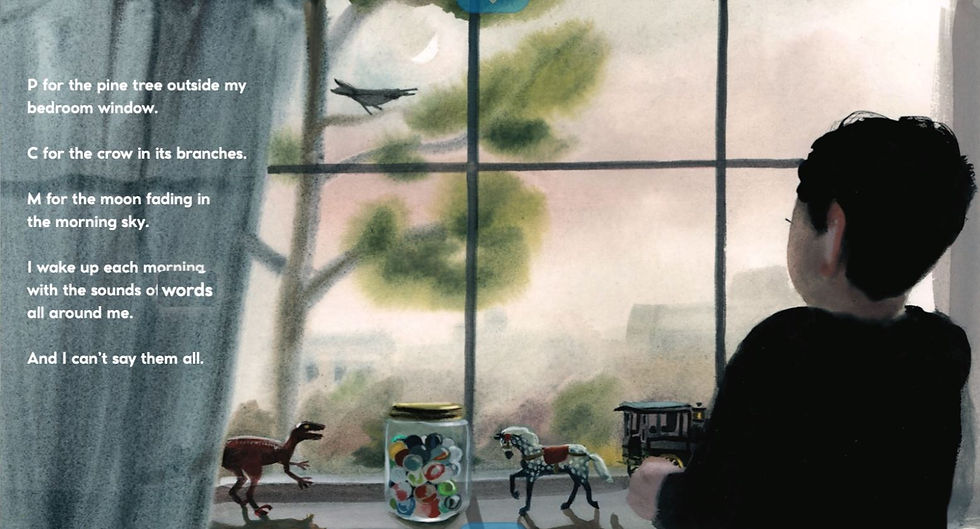
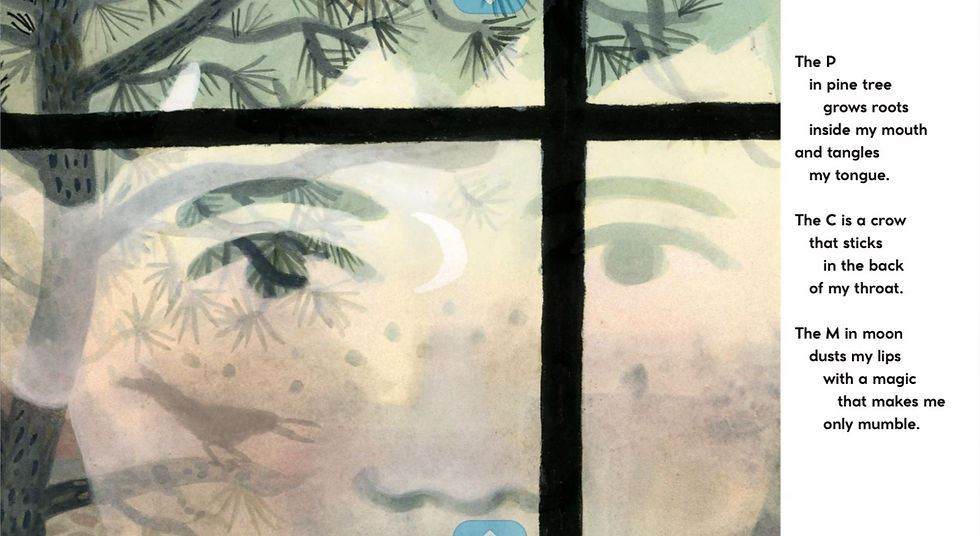
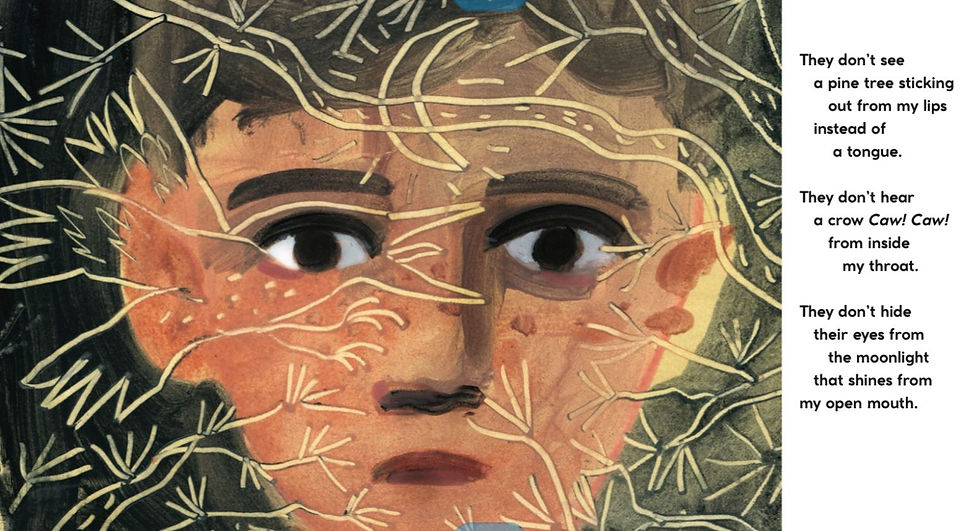
One reason I liked this strategy so much was because I thought it would be easy for younger readers and writers to follow along with. Picking these letters and continuing to refer back to them, incorporating additional information each time, throughout the story makes the underlying message stick out more to the readers. I would also argue that the corresponding illustrations add to the message of the story as well. In this case, it became clear to the readers that the boy's speech is something he struggles with greatly. Since a diagnosis or a label was never used in the book to tell the reader what it is exactly the boy was struggling with, the students would have to make an inference on what they think it is that the boy is struggling with, and I think this sequence of photos could help students do that.
I think that challenging students to do something similar in their writing would be an interesting practice to implement to aid students in improving their narrative writing. It can be difficult for students to determine how much detail is appropriate to include in their narrative writing, so you will need to introduce them to a wide variety of strategies they could choose from when writing. One strategy that is mentioned in my class text, Mentor Texts: Teaching Writing Through Children's Literature, K-6, is Using Illustrations to Add Detail. This strategy discusses how it can be easy for beginning readers to skip from the beginning to the end of the story as quickly as possible, leaving the middle of the story neglected with few details. Implementing this strategy will encourage students to slow down and add detail to their writing. To sum up this strategy, you will teach students how to add details to their writing through analyzing illustrations in different children's books.
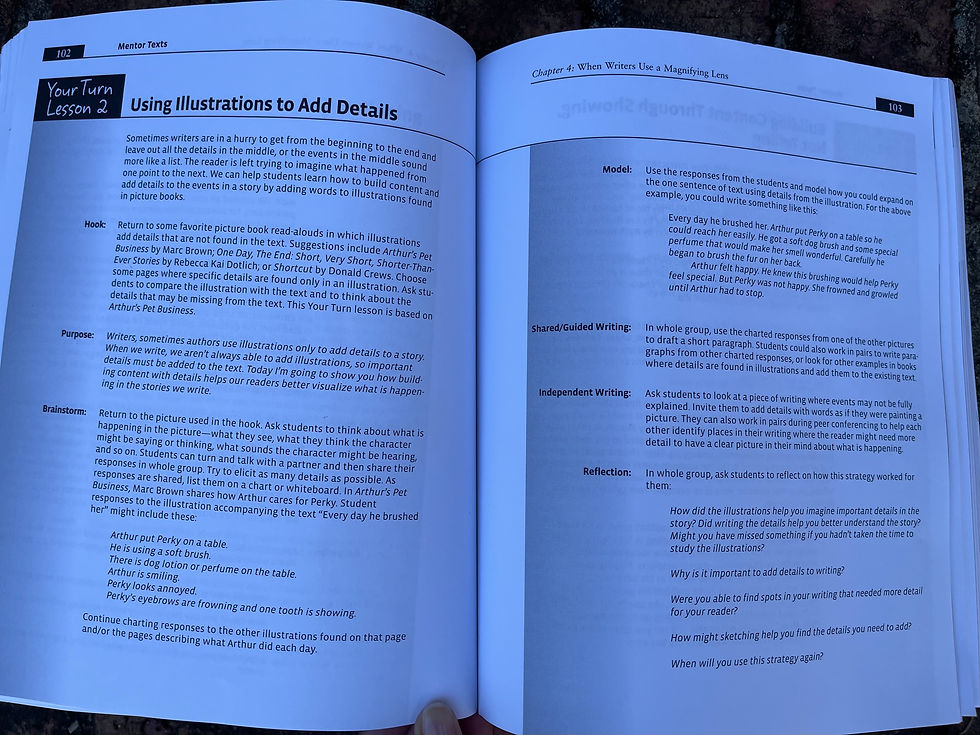
You could use I Talk Like a River as a mentor text, or you could choose from several other texts such as Drawn Together or We Are Water Protectors, all of which have detailed illustrations that students could easily describe using detail. The rationale behind this strategy is that in children's books the creator uses both text and illustrations to tell the story but when we create our own writing we may not have that luxury, leaving us relying on only our words to tell a story. If our words are bland and lacking detail our story will be as well, so this strategy could be one for students to try out when they're ready to add detail to their story.

Next I will discuss Drawn Together, written by Minh Le and illustrated by Dan Santat. This book shows an unlikely friendship forming between a boy and his grandfather. In the beginning we can see that the young boy is far from pleased to be spending time with his grandfather. He eats weird foods, watches interesting shows on the television, and he doesn't even speak the same language, what could they possibly do to have fun? Well, this question was quickly answered once the boy pulls out his drawing pad. It was at this point that their two vastly different worlds collided as they found a common interest, drawing. Even though their drawing styles are quite different, they still had a lot to share and were able to form a close-knit bond over this shared interest. Once again the illustrations stood out to me in this book, so much was said through just the use of illustrations. I will include a few of my favorite pages from the book below:

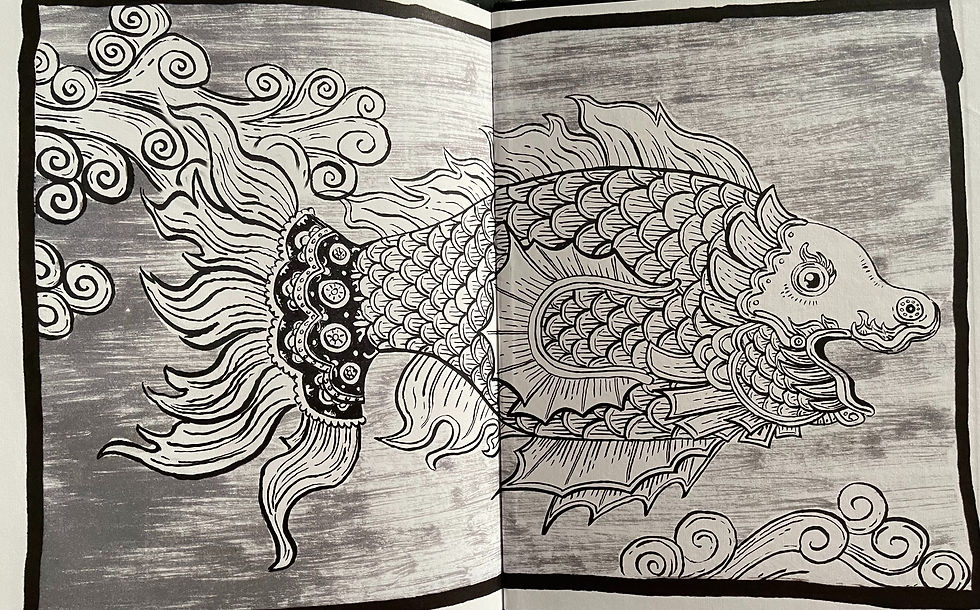
These two illustrations make up the end pages in this book. I loved seeing how each of the characters' artistic styles were portrayed in these drawings, truly showing that this book is a piece of work representing two different parts that come together to make one complete whole.

In this illustration you can see the grandfather and the boy switching wands, the tool they use to create astonishing artwork, in order to defeat a dragon. I would argue that the dragon represents the barrier that is keeping the two separate, their differences that are given more attention than their similarities. This shows that even though the two seem very different, they can still work together to achieve a common goal.
In these two pictures you can see how the creators of this book chose to style the cover of the physical copy of the book to match the grandpa's drawing notebook, shown later in the book. I loved this added detail because it made me feel like I was a part of the story, I even have the same book to prove it! This in addition to the other stylistic choices I observed in this book really stood out to me and I think readers of all ages would love reading this story!


This book could also be used as a mentor text to teach your students how to improve their own narrative writing. A strategy from my mentor text that I thought could pair well with this text is Adding a Satisfying Ending. Throughout this story the boy and his grandfather formed a close bond, which can be seen clearly when you compare the beginning scene to the final scene. When the boy arrives you can see that he is disappointed to be spending time with his grandfather. As the story progresses you can see the boy and his grandfather become closer and closer, until another array of illustrations on the final page of the book shows how the boy and his grandfather now have a special shared secret, which can be noted from observing the boy's smirking facial expression. The climax of this story takes place when the boy and his grandfather are fighting the dragon. The resolution, or the end, begins once they have conquered the dragon and are making their way back to each other, finally concluding once the boy's mother comes to pick him up. Personally, I find this ending incredibly satisfying because not only did they conquer the dragon, but they also tore down the barrier that was keeping them from becoming so close. Here I will include a sequence of illustrations from the book that show you how the story ended.
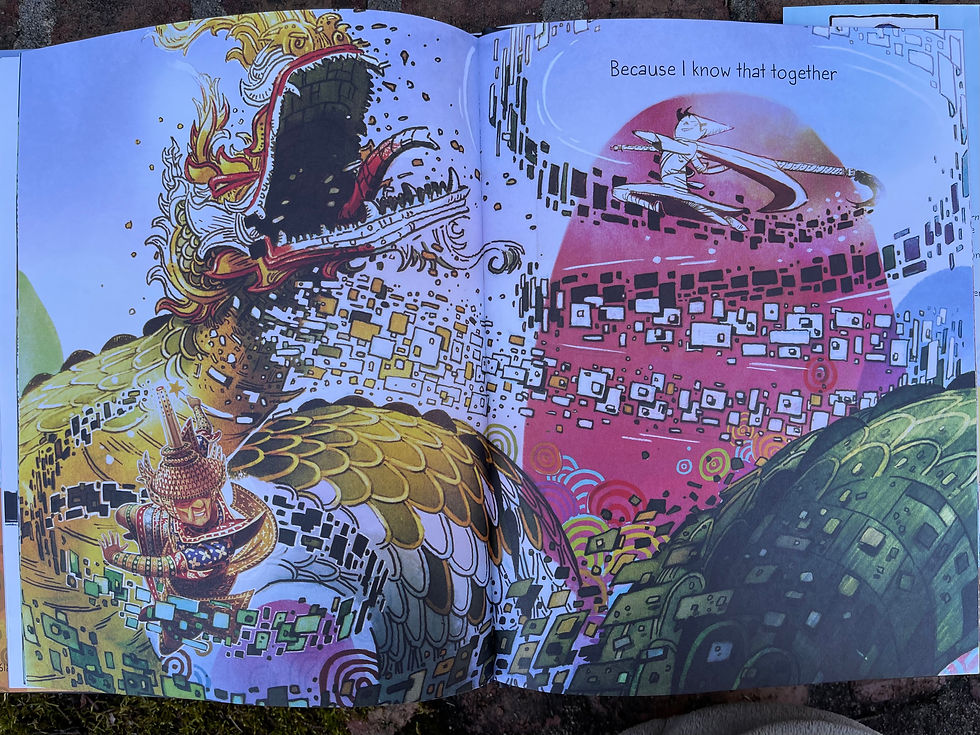

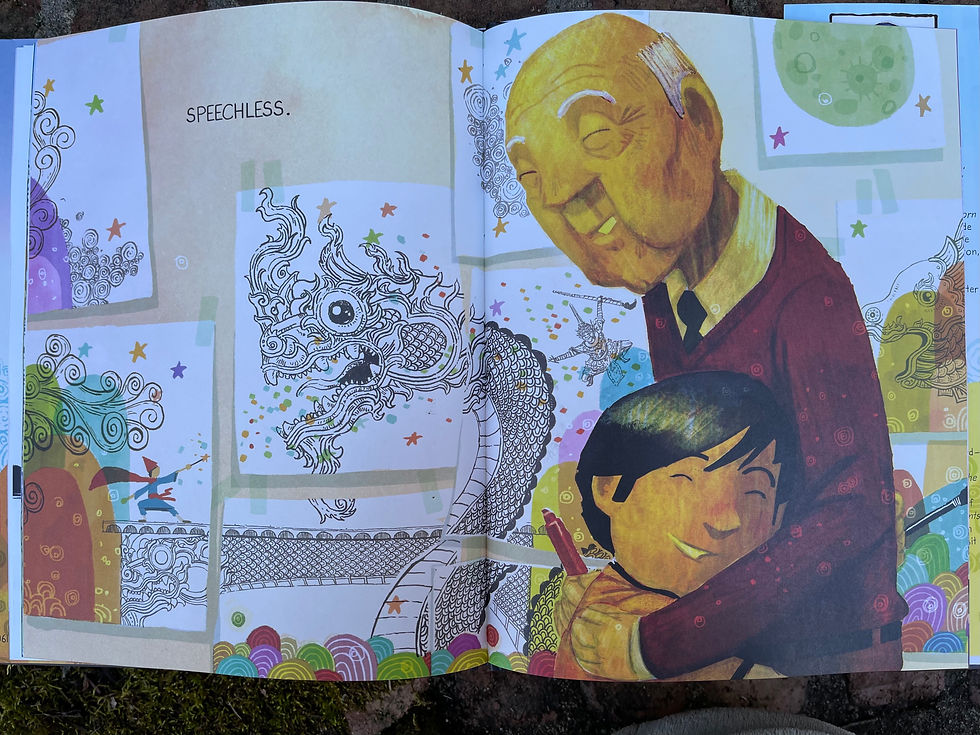

Implementing this strategy with students would be beneficial because it could teach them how to write their own satisfying ending. To sum up this strategy, you will first show students different captivating story endings (such as the one in Drawn Together) and challenge them to incorporate similar elements in their own story endings. This will show students how to enhance their writing by writing endings that their audience will find interesting.
Since I have been working on my own personal narrative recently, I thought it would benefit my writing if I were to implement one of these strategies. This week I will be revisiting my narrative about hitting my first homerun while implementing the strategy I previously described, Adding a Satisfying Ending. Before writing, I am going to keep in mind what elements the textbook chapter stated should be a part of a good story ending, making sure to incorporate some of those elements into my own ending. Here is this strategy fully laid out so you can see what I am referencing.

This strategy says, at the bottom of page 144, to try to include your thoughts and feelings as the main character, and combine it with either a final action, a future wish, a lesson learned, or a memory. For my narrative ending, I was discussing a very happy memory I had so I wanted to emulate that in my writing through adding details and selective words. Here is a picture of my "satisfying" ending.

Applying this strategy to my own writing allowed me to improve my work by encouraging me to describe my ending using a final action moment and to further enhance the story with my personal thoughts and feelings during the time of the event. Incorporating these additional details improved my ending by making it more engaging to read because there is enough information present for the writer to picture the event themselves. Although it is not my final draft I greatly appreciate how this strategy allowed me to improve my draft and grow as a writer.
More about the book creators:
I Talk Like a River:

Author: Jordan Scott
Website (more information on the book)

Illustrator: Sydney Smith
Drawn Together:

Author: Minh Le

Illustrator: Dan Santat



Comments